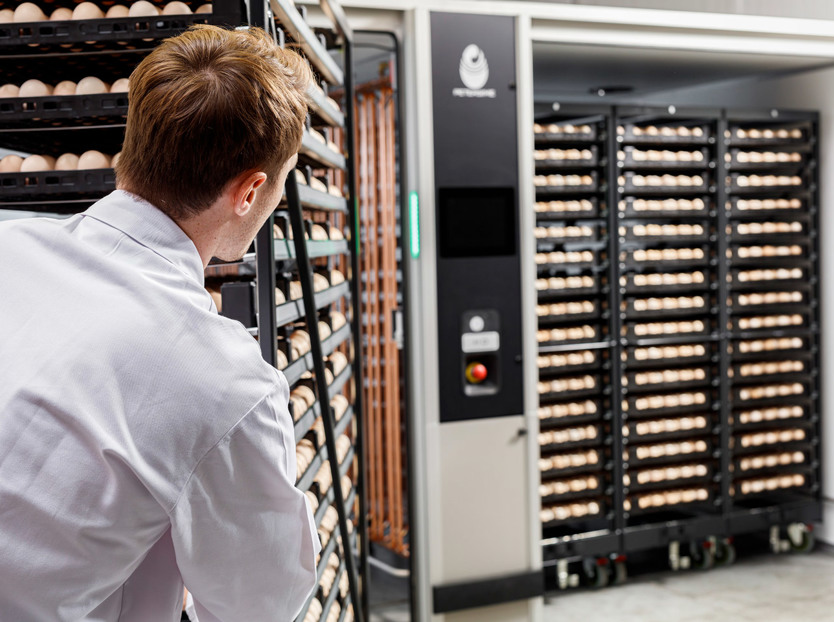Several factors are known to affect hatchability and chick quality. In addition to temperature, CO2/O2 and humidity control, egg turning is an important fourth parameter that determines the success of incubation and the quality of new-born chicks. In this article, we highlight why egg turning is so important and investigate the effect of increasing the turning frequency during early incubation by means of experimental-scale and commercial-scale trials.
The role of egg turning during incubation
Modern setters usually operate with a turning frequency of 24 times per day until the 18th day of incubation. Turning the hatching eggs plays a key role in embryonic growth:
- It ensures the embryo’s proper utilization of the albumen and yolk nutrients.
- It prevents adhesion of the embryo to the inner shell membrane and facilitates the movement of the embryo into the normal hatching position.
- It stimulates the growth of the ‘area vasculosa’ (vascularized area) of the chorioallantoic membrane (CAM).
Furthermore, egg turning is important for the embryo’s heat exchange. It optimizes the airflow dynamics in the incubator in a symmetrical manner. By regularly alternating the trays’ rotation position into the "A" and "V" profiles, the airstream passage through the eggs is improved in comparison to levelling the eggs horizontally.

From laboratory to commercial-scale trials: material and methods
The aim of our study was to evaluate the influence of an increased egg turning frequency during early incubation on young, prime and old flocks. The study was divided into 3 phases and carried out with the following partners:
- Ankara University (Turkey)
- Lar Cooperativa Agroindustrial (Brazil)
- Aviagen Latin America (Brazil)
- Redondos Alimentos (Peru)
- State University of Ponta Grossa (Brazil)
Phase 1 – Ankara University
In the first phase, 2,700 Ross 308 eggs per trial (young, prime and old flock ages) were randomly and equally distributed among 3 identical laboratory incubators (fixed 38° turning angle) to determine the influence of turning frequency:
- Turning program A: 96x daily (1 turning/15 min.) from 0-3d; 24x daily (1 turning/hour) from 4-18d
- Turning program B: 96x daily (1 turning/15 min.) from 0-7d; 24x daily (1 turning/hour) from 8-18d
- Turning program C: 24x daily (1 turning/hour) from 0-18d (control group)
Phase 2 – Lar, Aviagen and Redondos
As a next step, a commercial-scale trial was conducted with over 2.8 million eggs from commercial breeds (28 to 68 weeks) incubated in High Density and standard setters (monitored turning angles from 38°-40°) to compare the hatching results of:
- Increased turning frequency during the first week of incubation: 1 turning/15 min. from 0-3d, 1 turning/30 min. from 4-7d and 1 turning/hour from 7-18d
- Standard turning protocol: 1 turning/hour from 0-18d (control group)
Phase 3 – Aviagen and State University of Ponta Grossa
In the final phase, the blood vessel density in the chorioallantoic membrane was assessed in 112 eggs with an increased turning frequency, to obtain a detailed view of the vascular area by image processing (4 pictures/egg) according to the methods used by Fernandes et al. (2016). Photographic images of different samples were taken along the middle section of the egg equator.
Results and discussion
In Phase 1, increasing the turning frequency during the first week of incubation consistently improved hatchability. Best results were recorded for Group A and Group B, where the turning frequency was higher compared to a standard turning protocol (see graph 1: coloured bars versus grey bars). The improved hatchability was largely due to the beneficial effect of the higher turning frequency on late embryonic mortality.

In Phase 2, the increase in egg turning frequency resulted in average gains of 0.3% in hatchability, egg weight loss and lower embryonic mortality (mainly due to a reduced incidence of late embryonic mortality and consistently lower percentages of embryo malformation and malposition):
- 0.3% increase in total hatchability (see graph 2)
- 0.3% increase in egg weight loss (see graph 3)
- 0.3% decrease in total embryonic mortality (see graph 4)



In Phase 3, the percentage of vascularized area in the chorioallantoic membrane slightly increased in embryos at 11 days submitted to an increased egg turning frequency (see below images).

Conclusion
The turning of hatching eggs during incubation is vital for developing embryos. Rather than the classic hourly turning, our study indicates that increasing the turning frequency during the first week of incubation produces better hatchability, largely due to reduced late embryonic mortality. Interestingly, the study also demonstrates the growth of the vascularized area of the chorioallantoic membrane, and reports increased egg weight loss at transfer, which may be partially attributed to the increased vascularization in the chorioallantoic membrane.





